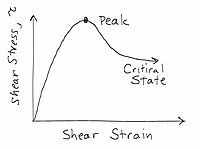
Photo from wikipedia
The mechanical behaviour of natural, unfilled rock joints is influenced by the interaction between surface roughness and matedness of the contact surfaces. In the field, natural rock joints normally exhibit… Click to show full abstract
The mechanical behaviour of natural, unfilled rock joints is influenced by the interaction between surface roughness and matedness of the contact surfaces. In the field, natural rock joints normally exhibit a mismatch between the contact surfaces, mainly due to different geological processes such as weathering or deformations. Various attempts have been made to estimate how matedness of rock joints influences their peak shear strength. However, the proposed methodologies imply certain difficulties since they are intended to estimate the matedness of rock joints based mainly on visual inspection, and by relating an initial shear displacement to the length of the analysed sample or by relating the opening of saw-tooth and two-dimensional joint profiles with the degree of interlocking. Therefore, a tested peak shear strength criterion for natural, unfilled rock joints that realistically accounts for the influence of matedness on their peak shear strength is still lacking. This paper presents a methodology where objective measurements of the average aperture of natural, unfilled rock joints are used to estimate their matedness as a step in the prediction of the peak shear strength. This measured average aperture is based on high-resolution optical scanning of the surface roughness. The proposed relationship between measured average aperture and matedness of natural rock joints has been included in a further developed peak shear strength criterion. The verification against ten natural rock joint samples of coarse-grained granite showed that the revised criterion can predict the peak shear strength considering rock joint matedness.
Journal Title: Rock Mechanics and Rock Engineering
Year Published: 2021
Link to full text (if available)
Share on Social Media: Sign Up to like & get
recommendations!